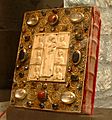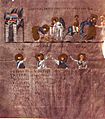Byzantine literature facts for kids
Byzantine literature is Greek literature written during the time of the Middle Ages. It was created in the Byzantine Empire, which was a continuation of the Roman Empire in the East. This literature is important because it connects ancient Greek writing with the Renaissance in Europe. It also tells us a lot about the history, religion, and daily life of the Byzantine people.
Contents
What is Byzantine Literature?
Byzantine literature is the name for all the books, poems, and other writings created in the Byzantine Empire. This empire lasted for over a thousand years, from about 330 AD to 1453 AD. The main language used was Greek, but it was a form of Greek that changed over time.
This literature is special because it mixed ideas from ancient Greece and Rome with Christianity. Writers often looked back to famous ancient Greek authors like Homer and Plato. But they also wrote a lot about Christianity, saints, and church history.
Different Kinds of Writing
Byzantine literature covered many different topics. It wasn't just one type of writing. Here are some of the main kinds:
History and Chronicles
Many Byzantine writers were historians. They wrote down the events of their time, like wars, emperors' reigns, and important decisions. These histories help us understand what happened in the empire. Some famous historians include Procopius and Anna Komnene. They wrote detailed accounts of their eras.
Another type of historical writing was called "chronicles." These were simpler histories. They often started from the creation of the world and went up to the writer's own time. They were popular because they were easier to read.
Religious Writings
Religion was a huge part of Byzantine life. So, a lot of literature was about Christianity. This included:
- Sermons and theological works: These were speeches given in church or deep discussions about religious ideas.
- Lives of saints: Stories about the lives of holy people. These stories often taught moral lessons.
- Hymns and church songs: Beautiful poems sung in churches. Many of these are still used today in the Eastern Orthodox Church.
Poetry and Epics
Poetry was also very important. There were different kinds of poems:
- Epic poems: Long poems that told stories of heroes. One famous example is Digenis Akritas. This poem tells the adventures of a brave border guard who fought against enemies of the empire. He was a legendary hero.
- Didactic poetry: Poems that aimed to teach lessons or give advice.
- Lyric poetry: Shorter poems that expressed feelings or described beauty.
Novels and Romances
While not as common as other types, the Byzantines also enjoyed stories. These were often called "romances" and were like early novels. They told tales of love, adventure, and brave heroes. These stories often had a moral message.
Encyclopedias and Handbooks
The Byzantines loved to collect knowledge. They created large encyclopedias that gathered information from many sources. The Suda is a huge example. It's like an ancient dictionary and encyclopedia combined. It contains information about history, literature, and science. These books helped preserve knowledge from ancient times.
They also wrote handbooks on various subjects. These could be about medicine, law, or how to run the government. These practical books were very useful for daily life and administration.
Important Writers and Their Impact
Many talented people contributed to Byzantine literature.
- Constantine VII Porphyrogennetos: He was an emperor who was also a scholar. He wrote books about how to govern the empire and its history. He encouraged learning and writing.
- Photius I of Constantinople: A very important church leader and scholar. He read thousands of books and wrote summaries of them. His work helps us know about many ancient texts that are now lost.
- Michael Psellos: A brilliant writer and philosopher from the 11th century. He wrote about history, philosophy, and many other topics. He was a very influential teacher.
Byzantine literature played a key role in keeping Greek culture alive. It also passed on knowledge to later generations, including people in Western Europe. When the Byzantine Empire fell, many scholars and their books moved to Europe. This helped kickstart the Renaissance and the renewed interest in ancient Greek and Roman learning.
Images for kids
-
An 11th-century Byzantine Gospel; its ornate presentation illustrates the decorative style employed by scholars of that age.
-
A page from a 16th-century edition of the vast Byzantine encyclopaedia, the Suda.
-
A Modern copy of a Byzantine Horologion, showing the daily cycle of the Eastern Orthodox Church.
-
The Scholar Emperor Constantine VII, being crowned by Christ.
-
An illustration of the Parable of the Good Samaritan from the Rossano Gospels, believed to be the oldest surviving illustrated New Testament.
-
The Troodos Mountains, from which Digenis Akritas used to jump to Asia Minor in the epic poem
See also
 In Spanish: Literatura bizantina para niños
In Spanish: Literatura bizantina para niños








